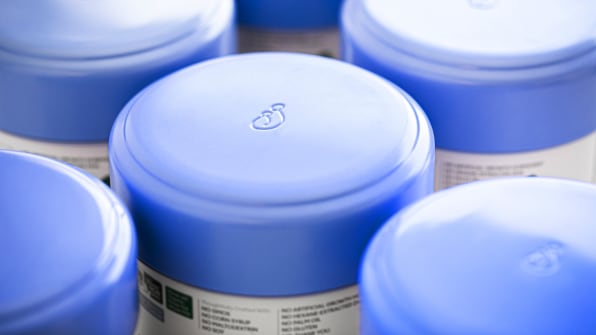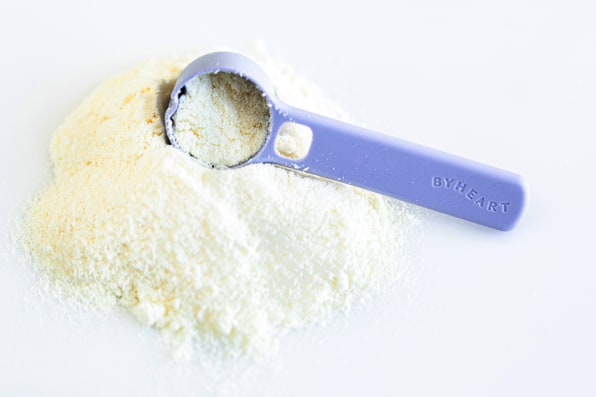How Is Genetic Engineering Used to Make Designer Babies
Looking at a store shelf stocked with baby formula, it seems like there's a plethora of options: more than 50 kinds, with varying ingredients and marketed to whatever your baby needs, whether they're constipated, colicky, or have been spitting up. But behind all those options on the shelf are just a few major companies. Three companies—Nestlé, Mead Johnson, and Abbott Nutrition—own 90% of the U.S. market; a fourth manufacturer, Perrigo, is well known for making generic formulas and formulas for other brands.
Even with all those options, when new formula company, ByHeart's co-founder Mia Funt transitioned from breast milk to formula for her child, she says she couldn't find a formula she "would feel proud" to feed her baby. "When I was choosing formula, I felt like every choice required a trade-off," says Funt, who was previously director of global business development and global product marketing at Huffington Post, AOL, and Verizon, and a WPP strategy consultant to Fortune 500 food and consumer good companies. Her baby was uncomfortable on formula, so her doctor suggested she choose one specifically for "easy digestion," but those options clashed with the kinds of ingredients Funt wanted to prioritize, since they often contained corn syrup and palm oil.
Given her past experience, Funt thought she could do better. She set out with her brother, Ron Belldegrun—who founded Consumer Health Ventures, a life science venture capital firm; previously spent eight years at healthcare investment fund Visium Asset Management; and is a board member of the Vagelos Life Science and Management Program at the University of Pennsylvania's Wharton School—to create what she calls a "no compromise" baby formula guided by breast milk research to be as close to the real thing as possible. With their combined experience in consumer tech and life sciences, Belldegrun says "we knew what it would take to actually innovate in this space." (Funt is ByHeart's president, Belldegrun is CEO.)
Building baby formula from the ground up

The first step to that innovation was to create their own manufacturing facility, rather than go through one of the companies that have long dominated the formula manufacturing space. It would have been easier to follow that traditional route—if they had, Belldegrun says, they could have been on the market within a year—but instead, they wanted to build everything themselves, from the ground up. ByHeart will have its own manufacturing facility, supply chain, and in-house research and development capabilities, and is currently completing its own clinical trial with 300 babies involved, which it says is the largest in the U.S. for a new infant formula brand in the last 25 years (For comparison, a trial first posted in December 2020 by Nara Organics had 160 participants; a 2019-completed trial by Nestlé had 194 participants.)
"We believe that the more you control of the process, the more you control the quality of the formula, and you can truly create the best nutrition for babies," Belldegrun says. ByHeart spent nearly five years, he adds, working with pediatric nutritionists and breast milk researchers to develop its formula—one he says uses breast milk "as a blueprint." Whereas other formulas often use proteins from skimmed milk or whey concentrates, ByHeart says it worked with breast milk researchers and pediatric nutritionists to create its own recipe and source its own proprietary protein blend "that gets closer to breast milk protein than ever before." ByHeart is awaiting FDA registration of its infant formula and facility which is required prior to entering the U.S. market. Devon Kuehn, a board-certified pediatrician and neonatologist, is ByHeart's chief medical officer; 12 other experts are involved with the company.
How parents feed their babies is deeply personal, and it was personal to Funt. With her first child, she chose to introduce formula because she was going back to work. With her second, she introduced formula because her appendix ruptured. "I used formula with both kids once by medical necessity and once entirely by personal choice," she says, "but in either case, I and all parents really deserve to feel confident in the first food that we feed our babies."
How do you market a formula?

Infant nutrition is, unsurprisingly, tightly regulated by the FDA, with requirements for minimum amounts of 30 nutrients (and maximums for 10 of those 30), including protein, fat, and vitamins and minerals like vitamins A and D, iron, and calcium. An FDA spokesperson confirmed that there are just six infant formula companies registered with the FDA for sale in the U.S. (including the aforementioned Nestlé, Mead Johnson, Abbott Nutrition, and Perrigo), though it doesn't maintain a public list.
The FDA spokesperson also noted that "the FDA has the authority to take compliance action if a new infant formula that does not meet the required nutrient specifications is marketed." And it has: The FDA told consumers to stop using formula from that startup Bobbie when it was revealed the formula was manufactured in Germany and didn't have sufficient nutrients for some infants, per U.S. standards. (Bobbie is now produced by Perrigo, it's formula has been revised, and it is now FDA-approved.)
Because of these strict standards, "any formula would give their baby what they need," Jennifer Harris, who researches baby formulas and toddler milks and their marketing at the UConn Rudd Center for Food Policy & Obesity, assures parents. Her research has primarily focused on how formulas are marketed, and how that marketing can confuse or mislead parents into thinking that infant and toddler formulas have nutrition not present in breast milk.
Harris is wary of brands that market themselves as "closest to breast milk," because they may prompt parents to choose formula rather than try breastfeeding, which is considered among pediatric nutritionists as the gold standard for infant health. "I don't think companies should be making profits out of convincing parents that they don't need to breastfeed their child," she says. "There should be options if you can't, but to try to convince mothers that they don't need to because this other thing is just as good, that sounds unethical to me."
ByHeart agrees breastfeeding is best, but the founders acknowledge that some women can't, or need to supplement their baby's nutrition because they have to get back to work or otherwise don't have the time and ability to continue breastfeeding. "I, like most parents, really saw breast milk as the most functional and natural nutrition there is," Funt says. "So when I moved to formula, I became completely overwhelmed and insecure about how to move forward, and I couldn't find a formula I felt proud to feed my baby." That, she says, was the impetus for founding ByHeart. How a parent decides to feed their baby, she adds, "is the first and incredibly intimate decision we make as parents, and this choice is determined by many different personal circumstances."
'We know more about breast milk than we ever have.'
With a proprietary blend of ingredients, ByHeart says its infant formula is designed to deliver the holistic benefits of breastmilk—not just enough calories to spur a baby's weight, but the immune, microbiome, and digestive health benefits baby's need—above the industry standard. "The proteins that we selected are some of the most abundant proteins in breast milk, and we have naturally derived them, naturally sourced them, and created a blend that gets significantly closer to that of breast milk," Belldegrun says. "We're at an extremely exciting time in nutrition science and breast milk research. We know more about breast milk than we ever have. The tools are finally there to create formulas that are better than those on shelf."
Their proprietary protein blend is one part of their formula. The other is their proprietary small batch blending process which Funt says "takes half the steps of the industry norm," and maintains the integrity of the ingredients. At the beginning of the process about five years ago, the team spent two months at the Agriculture and Food Development Authority in Ireland learning everything they could about the blending process. "What you put into formula is only half the story," Belldegrun says. "The way that you actually blend and prepare the dish is the other half of the story, to retain the nutritional integrity of the ingredients and treat them kinder, so they actually have the effect they're supposed to have."
When it is on the market, expected later in 2021, ByHeart's infant formula will be available exclusively on its website. The company will also launch an online platform for parents called Cluster that aims to be a "destination for feeding support and information," linking parents directly with nutrition science experts and resources on infant nutrition and feeding. In April 2020, ByHeart announced it secured $70 million in series A funding.
It's worth noting other formulas, currently on store shelves, have also pitched themselves as "Our closest to Breast Milk" or "modeled after breast milk." (How well ByHeart's formula compares may be revealed by its clinical study, which includes a 100 breast-fed baby reference arm, and is expected to be completed this summer.) There's also been a growing movement to literally replicate breast milk by growing it in a lab, both for the health benefits (though breast milk is often referred to as "personalized medicine" because of the way it adapts over time or includes specific benefits from a particular mother, like COVID-19 antibodies) and environmental ones. Baby formulas can often include palm oil, which has a noticeable environmental impact, and cow's milk as a starter, meaning the environmental impact of cows are included in the industry's carbon and water footprint.
ByHeart is thinking about this impact, too, and says it has committed to sustainable sourcing and regenerative agriculture. "We are working hard in an industry where there's been a lot of plastic to be the first company with an all-metal infinitely recyclable package," Belldegrun adds. It's another way, he says, that building ByHeart from the ground up and owning its end-to-end production has helped him and Funt take control over all these aspects, and hold their partners to account. "It's incumbent on us to not just be considering the product we're developing, but, if we're a company for babies, also considering the world we're leaving behind for them to inherit."
How Is Genetic Engineering Used to Make Designer Babies
Source: https://www.fastcompany.com/90639417/can-this-startup-engineer-a-better-baby-formula
0 Response to "How Is Genetic Engineering Used to Make Designer Babies"
Post a Comment